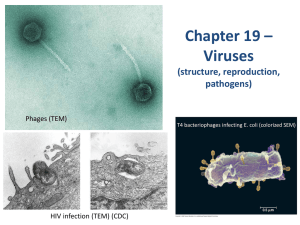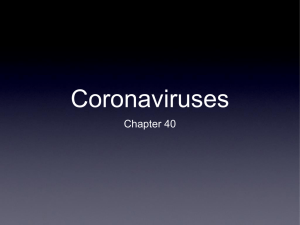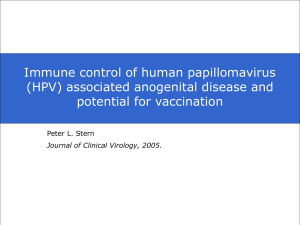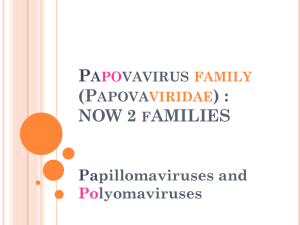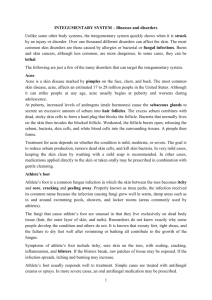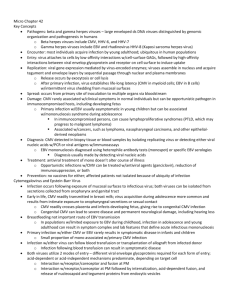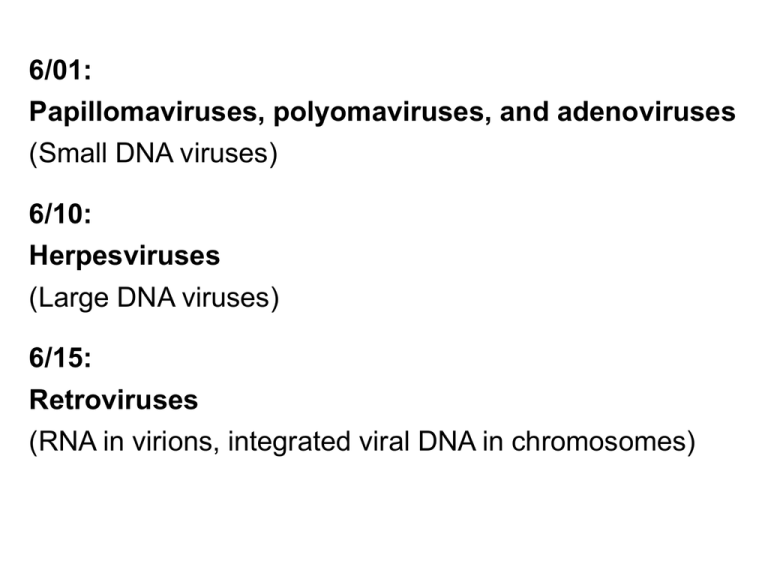
6/01:
Papillomaviruses, polyomaviruses, and adenoviruses
(Small DNA viruses)
6/10:
Herpesviruses
(Large DNA viruses)
6/15:
Retroviruses
(RNA in virions, integrated viral DNA in chromosomes)
40~50 nm
70~90 nm
100~200 nm
>100 kb
5~40 kb
Viruses with oncogenic potential:
• Papillomaviruses HPV
• Polyomaviruses
• Adenoviruses
• Herpesviruses
EBV, KSHV
• Retroviruses
HTLV
• Hepadnaviruses HBV
• Flaviviruses
HCV
Viral genome replication
in nucleus!
I.
Viral particle
II.
Viral genome
III. Life cycle
IV. Infection and immunity
V. Diseases
VI. Diagnosis
VII. Treatment and control
Papillomaviruses
I. Viral particle: nonenveloped icosahedral capsid
(resistant to inactivation!)
II. Viral genome: circular dsDNA
(At least 100 types based on DNA sequence homology:
very tissue-specific)
(bp)
E: early genes; L: late genes
III.
Life cycle:
Tissue/cell-dependent!
L1, L2
E1, E2
E6, E7
Tumor suppressors
IV. Infection and immunity:
•
Transmission: direct contact, sexual contact, birth canal
•
Targets: skin (cutaneous HPV) or mucosa (mucosal HPV)
•
Major pathogenesis: warts and tumors
•
Local infection
•
Immune control: innate and cell-mediated immunity
•
Persistent infection and recurrence
•
Symptomatic and asymptomatic infection and shedding
L1, L2
“Persistent infection”
E1, E2
E6, E7
• Low-level Ag expression
• Immuno-privileged site
V. Diseases:
•
Skin warts: HPV 1~4 (3~4 months for development)
•
Anogenital warts (condylomata acuminata): HPV 6, 11
•
Benign tumors (oral or laryngeal papillomas): HPV 6, 11
•
Cervical dysplasia and carcinoma: HPV 16, 18
(1~4 years for development)
•
Anogenital or oropharyngeal cancers: HPV 16, 18
Warts:
Progression of HPV-mediated
cervical carcinoma:
HPV DNA integration/breaking site in cervical carcinoma
VI. Diagnosis:
•
Histological examination of warts
(prickle cell hyperplasia and hyperkeratosis)
•
Papanicolaou-stained cervical smear (Pap smear)
(Koilocytotic cells)
•
Detection of HPV DNA
(PCR, in situ hybridization, sequencing/typing)
•
Immunodetection of viral antigens
•
No virus culture!
Koilocytosis (vacuolated cytoplasm)
in Pap staining of HPV-infected cells
VII. Treatment and control:
•
Removal of warts
•
Induction of local inflammation
(imiquimod, interferon)
•
Local treatment with cidofovir
(selective killing of HPV-infected)
•
HPV vaccine (L1 viruslike particles of HPV 6, 11, 16, 18)
(reduction of anogenital warts and cervical cancer)
•
Safe sex and avoiding direct contact of infected tissues
Polyomaviruses
BK virus and JC virus in human
Simian vacuolating virus 40 (SV40) in monkey
I.
Viral particle: nonenveloped capsid
II. Viral genome: circular dsDNA
Early genes:
For viral DNA replication
Late genes:
For virion assembly
SV40
5 kb
Large T
antigen
Tumor suppressors
III. Life cycle:
IV. Infection:
•
Transmission: maybe respiratory route
•
Infection of lymphocytes and spread through viremia
•
Ubiquitous, asymptomatic and persistent infection
(infection before 15 yo)
•
Latency: BK in kidney; JC in kidney, B cells or myeloid cells
•
Reactivation during pregnancy (no effect on fetus)
or in immunocompromised patients
V. Diseases: in immunocompromised patients
•
BK virus: renal diseases
Ureteral stenosis or hemorrhagic cystitis
•
JC virus: progressive multifocal leukoencephalopathy (PML)
Partial transformation of astrocytes (glioblastoma-like)
Lysis of oligodendrocytes (demyelination)
10% of AIDS patients, dying within 2 years
•
No human cancer
Immunocompromised
VI. Diagnosis:
•
PML: brain lesions with demyelination in white matter
•
PCR detection of viral DNA in urine or cerebrospinal fluid
•
Immunodetection of viral antigens in affected tissues
•
Urine cytologic test: enlarged cells with basophilic inclusions
•
No virus isolation
VII. Treatment and control?
Prevention from immunosuppression
Adenoviruses
I. Viral particle: nonenveloped icosadeltahedral capsid
(resistant to drying, detergents, protease, acid, mild chlorine)
Penton bases with fibers:
• Viral attachment to cell receptors
(Receptor: CAR)
• Virus entry through endocytosis
(Coreceptor: integrin αvβ3/αvβ5)
• Serotype-specific antigens
• Inhibition of host mRNA transport
and protein synthesis
II. Viral genome: linear dsDNA with 5’ terminal protein
Tumor suppressors
/PKR
• E3 19 kD protein reduces MHC class I to prevent antigen presentation.
• E3 14.7 kD protein inhibits TNF-a production.
III. Life cycle:
•
In permissive cells:
Viral replication, cell death with virion production
•
In nonpermissive cells:
Latency with viral genomes in the nuclues
Cell transformation in rodent cells
IV. Infection and immunity:
•
Transmission: aerosol, close contact, fecal-oral routes
•
Primary targets: mucoepithelial cells (serotype-dependent)
•
Major pathogenesis: cell lysis and tissue damage
•
Local infection and spread through viremia
•
Immune control: antibody and cell-mediated immunity
•
Persistent infection in lymphoid tissues
•
Symptomatic and asymptomatic infection and shedding
Oral route
V. Diseases:
•
•
•
Children (<14 yo) and people in crowded areas are at risk.
Immunocompromised patients may have more serious diseases
No human cancer
(Ad 1, 2, 5, 6)
(Ad 4, 7)
(Ad 40-42)
Adenovirus respiratory infection
VI. Diagnosis:
•
Virus isolation from affected tissues
(culture in epithelial cells, ~ 6 days)
•
Detection, typing, and grouping by immunoassay or PCR
VII. Treatment and control:
•
No approved treatment for adenovirus infection
•
Live Ad 4 and 7 vaccines for military recruits
•
Careful handwashing and chlorination of swimming pools
Adenoviral vectors
for gene delivery:
Generation of adenoviral vectors:
E1
Advantages?
Disadvantages?
6/10
6/01
6/15

